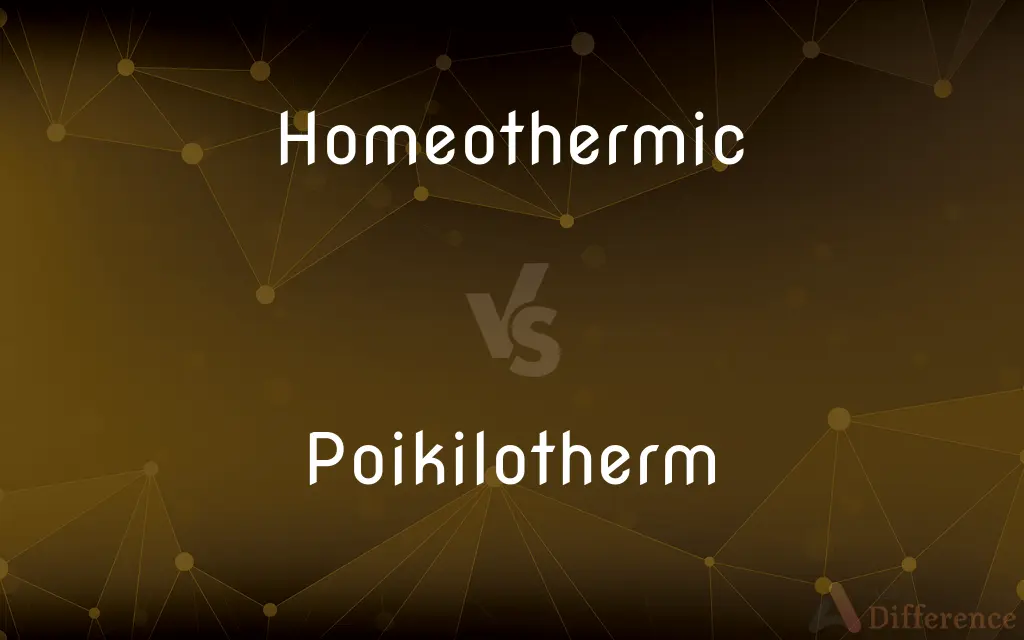Homeothermic vs. Poikilotherm — What's the Difference?
Edited by Tayyaba Rehman — By Fiza Rafique — Updated on November 2, 2023
Homeothermic organisms maintain a constant body temperature, while poikilotherms have a body temperature that varies with the environment.

Difference Between Homeothermic and Poikilotherm
Table of Contents
ADVERTISEMENT
Key Differences
Homeothermic animals regulate their body temperature internally, keeping it constant despite environmental changes. They do so by metabolic means – generating heat from within when it's cold outside and cooling processes when it's hot. Birds and mammals typically fall under this category, which allows them to inhabit a diverse range of environments, from the Arctic tundra to the scorching deserts.
On the flip side, Poikilothermic creatures do not maintain a constant body temperature. Instead, their body temperature fluctuates with the ambient temperature. This characteristic is found in animals such as reptiles, amphibians, and fish. Poikilotherms often rely on behavioral adaptations to regulate their temperature, such as basking in the sun to warm up or seeking shade to cool down.
Homeothermic species have adaptations like fur, feathers, sweat glands, or layers of fat, which aid in their thermoregulation efforts. These adaptations make them energetically more demanding, as they have to eat more food to maintain their temperature homeostasis.
Poikilotherms, in contrast, tend to require less energy for maintaining body temperature and can survive on fewer resources. However, their dependence on environmental temperatures to regulate their body heat often limits their activity during extreme weather conditions.
While homeothermic animals have the advantage in colder climates due to their internal heat generation, poikilotherms are more efficient in terms of energy in warm climates, where external conditions do not require constant internal temperature regulation.
ADVERTISEMENT
Comparison Chart
Temperature Regulation
Maintain constant body temperature
Body temperature varies with environment
Energy Consumption
Higher due to thermoregulation efforts
Lower, less energy for temperature maintenance
Environmental Adaptability
Can inhabit extreme climates
Active mostly in moderate environments
Physiological Adaptations
Fur, feathers, fat, sweat glands for temperature control
Behavioral methods like basking or burrowing
Examples
Mammals, Birds
Reptiles, Amphibians, Fish
Compare with Definitions
Homeothermic
An organism that uses metabolic heat to regulate body temperature.
Penguins are homeothermic, surviving Antarctic cold by huddling together.
Poikilotherm
A creature that cannot internally regulate its body temperature.
The fish in the pond, being poikilothermic, slowed down as the water cooled.
Homeothermic
Capable of maintaining a stable internal body temperature.
The homeothermic nature of dogs allows them to thrive in varied climates.
Poikilotherm
An organism whose body temperature adjusts to the ambient environment.
A snake, as a poikilotherm, sprawled on a rock to absorb warmth.
Homeothermic
Characteristic of an animal that can generate its own heat.
The homeothermic lion does not need to sunbathe like a lizard.
Poikilotherm
An animal whose enzymatic and physiological functions are temperature-dependent.
The desert iguana, a poikilotherm, is most active during the warmest part of the day.
Homeothermic
Pertaining to homeotherms, animals with consistent body temperatures.
Bears are homeothermic and maintain a steady temperature during hibernation.
Poikilotherm
An ectothermic organism with variable body temperature.
A poikilotherm, the frog must stay in its aquatic environment to regulate its temperature.
Homeothermic
A biological term describing thermoregulation regardless of external conditions.
Humans are homeothermic, which is why they can live in various climates.
Poikilotherm
Describing an organism that uses behavioral means to manage body heat.
Turtles, poikilotherms by nature, bask in the sun to elevate their body temperature.
Homeothermic
An organism, such as a mammal or bird, having a body temperature that is constant and largely independent of the temperature of its surroundings.
Poikilotherm
A poikilotherm () is an animal whose internal temperature varies considerably. Poikilotherms have to survive and adapt to environmental stress.
Homeothermic
(zoology) Capable of maintaining a relatively constant body temperature independent of the surrounding environment.
Poikilotherm
An organism, such as a fish or reptile, having a body temperature that varies with the temperature of its surroundings.
Homeothermic
Of birds and mammals; having constant and relatively high body temperature
Poikilotherm
Cold-blooded
Poikilotherm
A cold-blooded animal
Poikilotherm
An animal whose body temperature varies with the temperature of its surroundings; any animal except birds and mammals
Common Curiosities
What defines a homeothermic organism?
A homeothermic organism is one that maintains a constant body temperature through internal metabolic processes.
Do poikilotherms use more energy to maintain their body temperature than homeotherms?
No, poikilotherms generally use less energy for thermoregulation compared to homeotherms.
What are some adaptations of homeothermic animals?
Adaptations include fur, feathers, fat, and sweat glands.
Are all mammals homeothermic?
Yes, all mammals are considered homeothermic.
Can poikilotherms survive in cold environments?
Poikilotherms can survive in cold environments but are less active and may enter a state of dormancy.
Are all homeothermic animals warm-blooded?
Yes, being warm-blooded is synonymous with being homeothermic.
Can poikilotherms be active in any climate?
Poikilotherms are usually active in climates that do not have extreme temperatures.
Do homeothermic animals experience changes in body temperature?
While homeothermic animals maintain a relatively constant body temperature, they can experience minor fluctuations.
Can poikilotherms regulate their body temperature at all?
Poikilotherms can regulate their temperature to some extent through behavioral adjustments but not internally.
Do homeothermic animals have a higher metabolic rate than poikilotherms?
Generally, yes, homeothermic animals have higher metabolic rates to sustain constant body temperature.
What is the main advantage of being homeothermic?
The main advantage is the ability to remain active and survive in a wide range of environmental temperatures.
How do poikilotherms regulate their body temperature?
Poikilotherms regulate their body temperature through behavioral methods like sunning or seeking shade.
Is a shark considered a poikilotherm or homeothermic?
Most sharks are considered poikilothermic, but some have homeothermic characteristics.
Are birds considered homeothermic?
Yes, birds are considered homeothermic.
Do homeotherms or poikilotherms have a more stable enzyme function?
Homeotherms typically have more stable enzyme function due to their constant body temperature.
Share Your Discovery

Previous Comparison
Sweet vs. Savory
Next Comparison
Chairperson vs. ChairmanAuthor Spotlight
Written by
Fiza RafiqueFiza Rafique is a skilled content writer at AskDifference.com, where she meticulously refines and enhances written pieces. Drawing from her vast editorial expertise, Fiza ensures clarity, accuracy, and precision in every article. Passionate about language, she continually seeks to elevate the quality of content for readers worldwide.
Edited by
Tayyaba RehmanTayyaba Rehman is a distinguished writer, currently serving as a primary contributor to askdifference.com. As a researcher in semantics and etymology, Tayyaba's passion for the complexity of languages and their distinctions has found a perfect home on the platform. Tayyaba delves into the intricacies of language, distinguishing between commonly confused words and phrases, thereby providing clarity for readers worldwide.














































